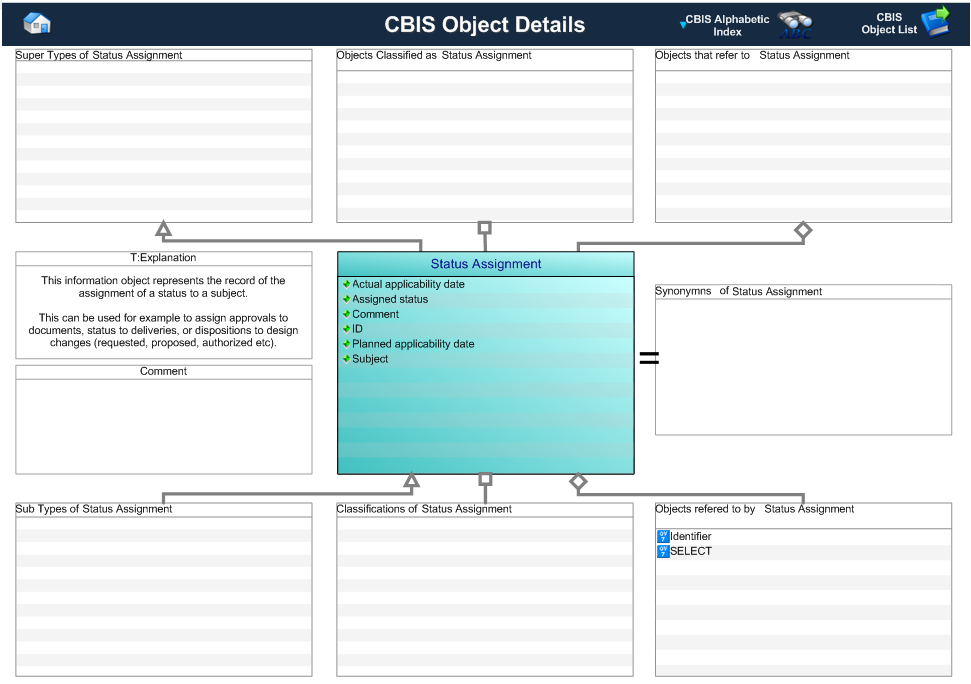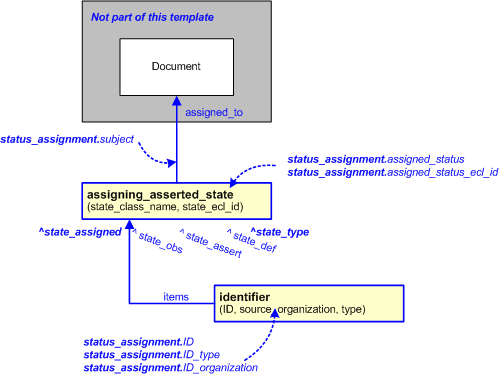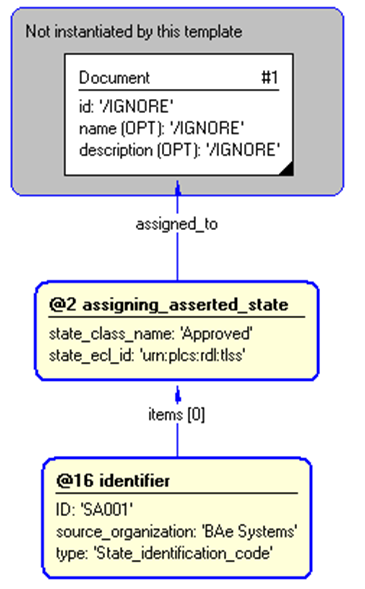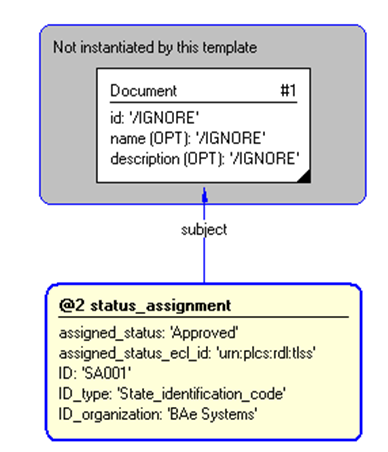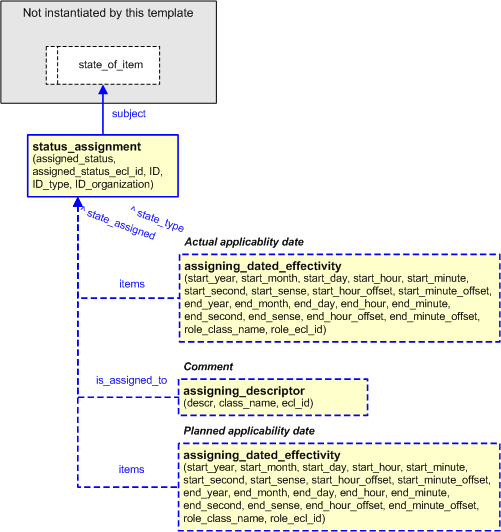Template:— status_assignment (st_asgn)
Context:— UK_Defence |
Date: 2009/04/17 11:50:21
Revision: 1.2
|
This section specifies the template status_assignment.
NOTE
The template has been defined in the context of
UK_Defence.
Refer to the business context for details of related templates.
NOTE
An explanation of a template and the associated instantiation path is
provided in the
Template overview
section.
This template describes how to represent the UK_Defence concept of a Status Assignment in terms of PLCS model elements (templates,
entities, and reference data).
The status assignment business object is used by those UK_Defence Data Exchange
Specifications that require information about the assignment of a status to a subject.
Figure 1 — Graphical Representation for Business Object Status Assignment
Status Assignment:
The definition of a Status Assignment is:
This information object represents the record of the assignment of a status to a subject.
This can be used for example to assign approvals to documents, status to deliveries, or dispositions to design changes
(requested, proposed, authorized etc).
|
Attribute name
|
Attribute description
|
Attribute type
|
Optionality
|
| Actual applicability date |
This is the date and time on which the status assignment actually took effect. |
intrinsic |
Optional |
| Assigned status |
This is the status that is assigned to the subject.
EXAMPLE
Typical examples may include "proposed", "approved", "obsolete".
|
intrinsic |
Mandatory |
| Comment |
This is a comment that may be associated with assignment of the status to the subject. |
intrinsic |
Optional |
| ID |
This is the identifier of the status assignment. |
Identifier |
Mandatory |
| Planned applicability date |
This is the date and time on which the status is planned to take effect. |
intrinsic |
Optional |
| Subject |
This is the reference to the subject to which the status is assigned. |
SELECT |
Mandatory |
Table 1 — Status Assignment attribute details
The EXPRESS-G diagram in
Figure
2
shows the templates and EXPRESS entities that are required
to represent the template
"status_assignment".
The text highlighted in blue shows the template parameters.
Figure 2 — An EXPRESS-G representation of the Information model for status_assignment
The graphic for the template to be used in other EXPRESS-G diagrams
is shown in Figure
3
below.
Figure 3 — The graphical representation of the status_assignment template
The following input parameters are defined for this template:
This is the status that is assigned to the subject.
The following classes and their sub-classes can be used:
The urn relating to the status
This is the identifier of the status assignment.
ID_type (Default=State_identification_code,Type='CLASS')
The class of the Identifier
The following classes and their sub-classes can be used:
The organization that is the source of the identifier
This is the reference to the subject to which the status is assigned.
The following reference parameters are defined for this template:
Allow the
State_observed
entity instantiated in this path to be referenced when this template is used.
Note: The
State_observed
entity can be referenced in a template path by:
%^target = $status_assignment.state_assigned%
Allow the
State_definition
entity instantiated in this path to be referenced when this template is used.
%^target = $status_assignment.state_type%
The following parameter combinations specify a uniqueness constraint:
Unique constraint: Assigned status
Each instance of the
entity
(
State_observed)
within the data set shall be uniquely identified
by a combination of the following parameters on this
template (status_assignment) namely:
assigned_status,
ID,
subject.
The
instance is
referenced by the following template parameter:
state_assigned.
The instantiation path shown below specifies the entities that are to be
instantiated by the template.
A description of templates and the syntax for the instantiation path is
provided in the
Templates Help/Information section.
/
assigning_asserted_state(
state_class_name=@assigned_status,
state_ecl_id=@assigned_status_ecl_id,
assigned_to=@subject)/
%^state_assigned = $assigning_asserted_state.state_obs%
%^state_type = $assigning_asserted_state.state_def%
/
identifier(
items=^state_assigned,
ID=@ID,
type=@ID_type,
source_organization=@ID_organization)/
The instance diagram in Figure
4
shows an example of the EXPRESS entities and templates that are instantiated by the template:
/status_assignment(assigned_status='Approved', assigned_status_ecl_id='urn:plcs:rdl:std', ID='SA001', ID_type='State_identification_code', ID_organization='BAe Systems', subject='#1')/
(an illustration of the consolidated status_assignment template is shown in
Figure
5 below.)
Figure 4 — Entities instantiated by status_assignment template
The instance diagram in
Figure
5
shows the graphic symbol for the template that is to be
used in other instance diagrams. The example template is:
/status_assignment(assigned_status='Approved', assigned_status_ecl_id='urn:plcs:rdl:std', ID='SA001', ID_type='State_identification_code', ID_organization='BAe Systems', subject='#1')/
Figure 5 — Instantiation of status_assignment template
The following section details how the
status_assignment
template can be optionally characterized by assigning
other constructs to it. These are characterizations commonly
applied to the template. The ISO 10303-239 EXPRESS model may enable
other assignments to the entities instantiated by the template.
The EXPRESS-G diagram in Figure
6
shows the possible characterizations of the template
"status_assignment".
Figure 6 — Characterizations for status_assignment
The following characterizations may apply:
Characterization Actual applicability date
NOTE this characterization is optional.
The date and time on which the status assignment actually took effect.
/assigning_dated_effectivity(start_year='2005', start_month='11', start_day='22', start_hour='15', start_minute='15', start_second='00', start_sense='ahead', start_hour_offset='2', role_class_name='Actual_effectivity', role_ecl_id='urn:plcs:rdl:std', items='@99')/
Characterization Comment
NOTE this characterization is optional.
The comment to the Status assignment can be provided using instances
of the template assigning_descriptor.
These are applied to the ^state_assigned reference parameter. See Figure 6 for the an abstract view of this.
The following template call shows how this might be instantiated with respect to Figure 5.
/assigning_descriptor(descr='This is the comment', class_name='Status_assignment_comment', ecl_id='urn:plcs:rdl:uk_defence', is_assigned_to='@2')/
Characterization Planned applicability date
NOTE this characterization is optional.
The date and time on which the status assignment is planned to take effect.
/assigning_dated_effectivity(start_year='2005', start_month='11', start_day='22', start_hour='15', start_minute='15', start_second='00', start_sense='ahead', start_hour_offset='2', role_class_name='Planned_effectivity', role_ecl_id='urn:plcs:rdl:std', items='@99')/
